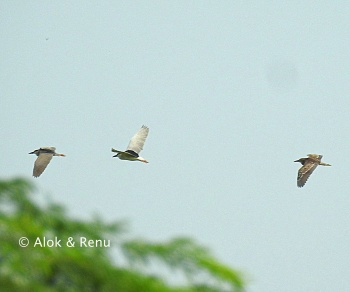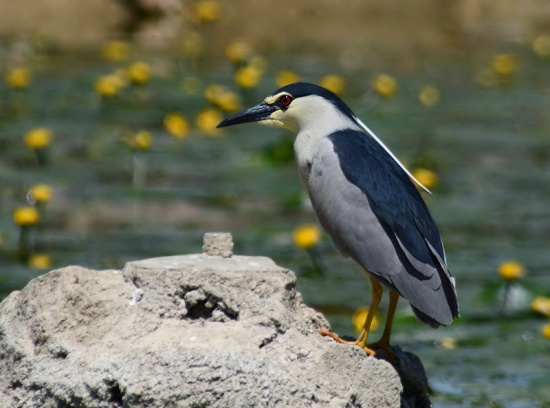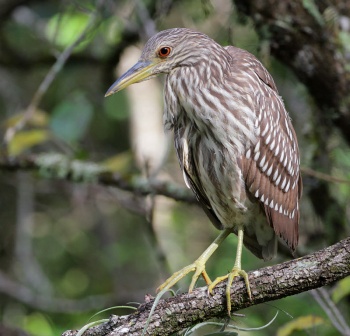- Nycticorax nycticorax
Identification
Length 51-70 cm (25 in), wingspan 100-112 cm, weight 520-800 g
A medium-small, rather stout heron, looking stocky and short-necked when at rest
Adult
- Black crown, lores, and back
- Narrow white forehead
- Two slender white plumes on the rear of the head in the breeding season
- Eye bright red
- Bill black in breeding season, often with yellowish-grey base in rest of year
- Rest of body white or pale grey below
- Wings and tail dark grey
- Short yellow legs, becoming bright pink to red during courtship in spring
First-year young birds
- Dark brown above, paler brown below, with white to pale buffy-brown teardrop marks on all feather tips
- Legs duller, often greenish- or greyish-yellow
- Eye yellowish to orangey
- Bill with yellowish-grey base
Second year subadult birds
- Similar to adult, except dark grey-brown where adult is black, and breast streaked dark grey
- Bill black or with yellowish-grey base
Variations
The subspecies differ mainly in breast darkness, with N. n. hoactli the palest, N. n. nycticorax intermediate, and N. n. obscurus and N. n. falklandicus the darkest, dusky grey below. Some authorities treat N. n. falklandicus as a synonym of N. n. obscurus[3]. Juvenile and second year plumages are not reported to differ between subspecies.
Similar species
Adults are very distinctive, with few confusion possibilities. Nankeen Night Heron overlaps locally in southeast Asia; it differs in being reddish-brown where Black-crowned is dark grey. In South America, the Boat-billed Heron has a similar plumage pattern, but is smaller and with an obviously large, swollen bill.
Juveniles are more easily confused with other brown herons; Botaurus bitterns are markedly larger, while juvenile Ixobrychus bitterns are smaller.
The most similar immature heron is Yellow-crowned Night Heron in the Americas (which see).
Distribution
Near cosmopolitan, throughout warmer areas of Europe, Africa, Asia, North, Central, and South America. Missing from Australasia, where it is replaced by the closely related Nankeen Night Heron, and Antarctica.
Europe
Patchy breeding range across southern and central Europe from Iberia to Greece and Turkey, and north to France, the Netherlands, and Russia. Its range is currently expanding slowly north following better protection, with the first modern breeding record in Britain in 2017.
It is a summer visitor to all its European range, with birds migrating to subsaharan Africa in winter. Overshooting spring migrants are regularly seen in Britain (>500 records), usually May-June, more rarely north to Iceland and the Faroes, Norway, Finland, and Estonia. Also recorded on the Azores, Madeira, and Cape Verde Islands.
There are also feral colonies in Belgium which are the descendants of released birds, and formerly also in Norfolk, England and around Edinburgh Zoo, Scotland (the latter were of the subspecies N. n. hoactli).
Asia
In Asia breeds from the Caspian east to China and Japan and south to India and Sri Lanka, Malaya, Borneo and Sumatra. Birds in central Asia are migratory, those in southern Asia are resident.
Africa & Middle East
Widespread in subsaharan Africa from Senegal to Somalia and south to the Cape but breeding records are widely scattered. Also small numbers in northwest Africa, the Nile Delta and parts of the Middle East.
Americas
Breeds in south-central and south-eastern Canada and over much of the USA except the mountains of the west. Also occurs in the West Indies and from Mexico south to Panama and over most of South America except the higher Andes and Amazonia. Also breeds in the Falkland Islands and Hawaii. Northern birds are migratory and winter in south-west and south-east USA.
Taxonomy
Subspecies
Clements recognises the following subspecies [1],[2]:
- N. n. nycticorax: Eurasia south to Indonesia, Africa and Madagascar
- N. n. hoactli: Southern Canada to northern Argentina and Chile, the West Indies (Greater Antilles), and Hawaii
- N. n. obscurus: Lowland northern Chile and north-central Argentina to Tierra del Fuego
- N. n. falklandicus: Falkland Islands

Photo © by Alok Tewari
Delhi Border, India, 22 August 2019
Habitat
Wooded swamps, well-vegetated margins of lakes and rivers. On passage and in winter sometimes in more open habitats, including brackish lagoons and estuaries.
Behaviour
Usually crepuscular.
Diet
An opportunistic feeder, their very varied diet consists of fish, and shellfish, leeches, earthworms, insects, amphibians, reptiles, such as lizards and snakes, turtles, rodents, birds, and their eggs. They also eat plants, carrion and forage at landfill sites.
Breeding
It builds a platform of sticks placed in tree or cattails and nests colonially; more than a dozen nests may be in a single tree. Clutch usually consists of 3-5 greenish eggs.
Vocalisation
Gallery
Click images to see larger version
Juvenile nominate subspecies
Photo © by Alok Tewari
Keoladeo National Park, India, July-2015Juvenile
Photo © by binus1963
Cuba, 4 October 2015
References
- Clements, J. F., P. C. Rasmussen, T. S. Schulenberg, M. J. Iliff, T. A. Fredericks, J. A. Gerbracht, D. Lepage, A. Spencer, S. M. Billerman, B. L. Sullivan, M. Smith, and C. L. Wood. 2024. The eBird/Clements checklist of Birds of the World: v2024. Downloaded from https://www.birds.cornell.edu/clementschecklist/download/
- Gill, F. and Donsker, D. (Eds). 2017. IOC World Bird Names (version 7.3). Available at http://www.worldbirdnames.org/.
- Del Hoyo, J, A Elliot, and J Sargatal, eds. 1992. Handbook of the Birds of the World. Volume 1: Ostrich to Ducks. Barcelona: Lynx Edicions. ISBN 978-8487334108
- Alvaro Jaramillo. 2003. Birds of Chile. Princeton Field Guides. ISBN 0-691-11740-3
- Handbook of the Birds of the World Alive (retrieved August 2015)
- surfbirds
- All About Birds
- Wikipedia
Recommended Citation
- BirdForum Opus contributors. (2025) Black-crowned Night Heron. In: BirdForum, the forum for wild birds and birding. Retrieved 16 May 2025 from https://www.birdforum.net/opus/Black-crowned_Night_Heron
External Links
GSearch checked for 2020 platform.1











